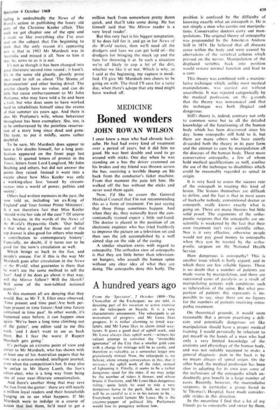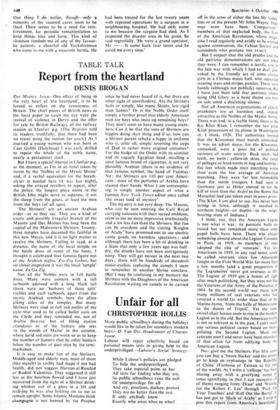MEDICINE
Boned wonders
JOHN ROWAN WILSON
I once knew a man who had chronic back- ache. He had had every kind of treatment over a period of years, but it did him no good. He was bent double and used to go around with sticks. One day when he was standing on a bus the driver crammed on his brakes and my friend was thrown across the bus, receiving a terrible thump on his back from the conductor's ticket machine. From that moment the pain left him. He walked off the bus without the sticks and never used them again.
Now, I'd like to assure the General Medical Council that I'm not recommending this as a form of treatment. I'm just saying that these things sometimes happen. And when they do, they naturally leave the con- ventionally trained expert a little red-faced. The doctor is placed in the position of an electronic engineer who has tried fruitlessly to improve the picture on a television set and then sees the job accomplished by a well aimed slap on the side of the casing.
A similar situation exists with regard to osteopathy. The orthodox view of osteopaths is that they are little better than television- set bangers, who assault the human spine without any clear idea of what they are doing. The osteopaths deny this hotly. The position is confused by the difficulty of knowing exactly what an osteopath is. He is not simply a man who carries out manipula- tions. Conservative doctors carry out man- ipulations. The original theory of osteopathy was propounded by the American Andrew Still in 1874. He believed that all diseases arose within the body and were caused by aberrations of the vertebral column which pressed on the nerves. Manipulation of the displaced vertebra back into position would restore normal function and lead to a cure.
This theory was combined with a manipu- lative technique which, unlike most medical manipulations, was carried out without anaesthetic. It was rejected categorically by the medical profession, on th.: grounds that the theory was nonsensical and that the technique was both illogical and dangerous.
Still's theory is, indeed, contrary not only to common sense but to all the detailed knowledge of the functioning of the human body which has been discovered since his day. Some osteopaths still hold to it, but there are many others who have quietly discarded both the theory in its pure form and the attempt to cure by manipulation all the diseases of the human body. These more conservative osteopaths, a few of whom hold medical qualifications as well, confine the use of the technique to disabilities which could be reasonably regarded as spinal inr origin.
It is very hard to assess the success rate of the osteopath in treating this kind of lesion. The lesions themselves are difficult to define, and the fact is that in most cases of backache nobody, conventional doctor or osteopath, really knows exactly what is going on. There are many theories but little solid proof. The arguments of the ortho- paedic surgeons that the osteopaths are un- scientific is weakened by the fact that their own treatment isn't very scientific either. Nor is it very effective, otherwise people would not pay good money to osteopaths when they can be treated by the ortho- medic surgeon on the National Health Service.
How dangerous is osteopathy? This is another issue which is hotly argued, and in which there are few reliable figures. There is no doubt that a number of patients are made worse by manipulation, and there are occasional cases of paralysis as a result of manipulating patients with conditions such as tuberculosis of the spine. But what pro- portion of patients this represents is im- possible to say, since there are no figures for the numbers of patients receiving osteo- pathic treatment.
On theoretical grounds, it would seem reasonable that a person practising a deli- cate and potentially dangerous art like manipulation should have a proper medical training. I would personally be reluctant to put myself in the hands of a man who had only a very limited knowledge of the anatomy and physiology of the human body, and was not suitably equipped to make a general diagnosis--pain in the back is by no means always of spinal origin. On the other hand, the medical profession has been slow in adapting for its own uses some of the technioues of the osteopaths which un- doubtedly give benefit in a large number of cases. Recently, however, the manipulative surgeons, in particular a group based in St Thomas's Hospital, have made consider- able strides in this direction.
In the meantime I find that a lot of my friends go to osteopaths and swear by them..
One thing I do notice, though—only a minority of the vaunted cures seem to be final. There seems to be a need for rein- forcement, for periodic remanipulation to keep things nice and loose. This kind of situation reminds me of one of my favour- ite patients, a cheerful old Yorkshireman who came to me with a recurrent hernia. He had been treated for the last twenty years with repeated operations by a surgeon at a neighbouring hospital. He had only come to me because the surgeon had died. As I inspected the disaster area in his groin, he said regretfully, `He were a grand operator, Mr —. It came back four times and he cured me every time.'



































 Previous page
Previous page